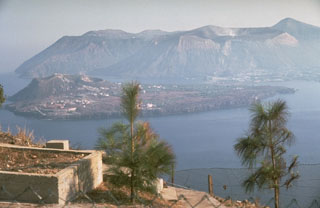Report on Vulcano (Italy) — April 1996
Bulletin of the Global Volcanism Network, vol. 21, no. 4 (April 1996)
Managing Editor: Richard Wunderman.
Vulcano (Italy) Decrease in fumarole temperatures
Please cite this report as:
Global Volcanism Program, 1996. Report on Vulcano (Italy) (Wunderman, R., ed.). Bulletin of the Global Volcanism Network, 21:4. Smithsonian Institution. https://doi.org/10.5479/si.GVP.BGVN199604-211050
Vulcano
Italy
38.404°N, 14.962°E; summit elev. 500 m
All times are local (unless otherwise noted)
The "La Fossa" crater was visited during 9-11 May by a group from the Federal Institute of Technology in Zurich. Fumarolic emissions were observed on the SW inner crater wall, on the outer N slope ~100 m below the crater rim, and on the NE outside flank about half way down from the rim towards the sea. During the night of 9-10 May, several new fissures, 2-3 m long and 2-5 cm wide, opened on the inner crater slopes. They formed as an extension of a major fissure reaching W from fumarole FF, concentric to the crater rim. Temperatures of gases emitted from these fissures ranged from 160 to 220°C. During the same night, pre-existing fissures widened by a few centimeters (
Fumarole temperatures were measured on the NE crater rim and on the inner crater flanks, but those from radial fractures in the inner crater were not measured. Maximum temperature observed was 507°C on an extension fissure of fumarole FF on the inner crater slopes (table 4). This compares to the maximum temperature of 552°C in the same period last year at the same location. Temperatures on the crater rim peaked at 326°C at fumarole F5 compared to 512°C last year. Temperatures of outlets situated at the edge of the slope from the inner crater to its floor reach a maximum of 435°C. Fumarole temperatures therefore showed decreasing trends, but maximum temperatures remained high. The decrease was strongest at the rim fumaroles.
Table 4. Measured temperatures at La Fossa Crater, Vulcano, in May 1995 and 1996. Fumaroles F0/F1 and F5 are located at the crater rim; FF, FA and the extension fissure occur in the inner crater. Courtesy of C. Wahrenberger.
| Fumarole | Max Temp 1-5 May 1995 | Max Temp 9-11 May 1996 |
| F0 | 369°C | 320°C |
| F1 | 302°C | 320°C |
| F5 | 512°C | 326°C |
| FF | 484°C | 435°C |
| FA | 474°C | 445°C |
| Extension fissure FF | 552°C | 507°C |
Temperature measurements were done using a Cr-Al Type K thermocouple at ~5 cm below the surface. All 1996 measurements were taken at the same locations as those made in 1995. Temperatures at each point were also taken on three successive days; deviations in 1996 were
Geological Summary. The word volcano is derived from Vulcano stratovolcano in Italy's Aeolian Islands. Vulcano was constructed during six stages over the past 136,000 years. Two overlapping calderas, the 2.5-km-wide Caldera del Piano on the SE and the 4-km-wide Caldera della Fossa on the NW, were formed at about 100,000 and 24,000-15,000 years ago, respectively, and volcanism has migrated north over time. La Fossa cone, active throughout the Holocene and the location of most historical eruptions, occupies the 3-km-wide Caldera della Fossa at the NW end of the elongated 3 x 7 km island. The Vulcanello lava platform is a low, roughly circular peninsula on the northern tip of Vulcano that was formed as an island beginning more than 2,000 years ago and was connected to the main island in about 1550 CE. Vulcanello is capped by three pyroclastic cones and was active intermittently until the 16th century. Explosive activity took place at the Fossa cone from 1898 to 1900.
Information Contacts: Christoph Wahrenberger, Terry M. Seward, and Volker Dietrich, Institute for Mineralogy and Petrography, Federal Institute of Technology, Sonneggstrasse 5, 8092 Zurich, Switzerland.

